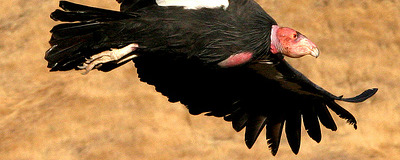Condors
Back from the brink

Not all the natural wonders in the Grand Canyon are below the rim. Search the skies for glimpses of the endangered California Condor, the largest land bird in the Western Hemisphere. But don’t be tricked by the common turkey vulture sharing the thermals. Condors, almost twice as big, have a 9.5-ft. wingspan, weight 23 pounds, and have a distinctive white triangle on the underside of each black wing. They soar up to 250 miles/day as high as 15,000 feet searching for dead animals by sight, not smell. They float over both rims, occasionally right over the viewpoints.
Condors disappeared from Arizona in 1924. By 1988 only 22 survived in the wild, all in California. They were removed and bred at the San Diego Zoo. Condors mate for life and produce one egg every other year. Reintroduction into the wild began in 1991 and at the Grand Canyon in 1996. In 2013, the wild population had grown to 230 with 125 in California, 28 in Baja California, and 80 birds in the Grand Canyon, including 6 recent releases. Yet breeding success remains precarious. No chicks survived the 2012 season. So search the sky and rejoice if you are one of the few humans to see Condors once again silhouetted against the blue.